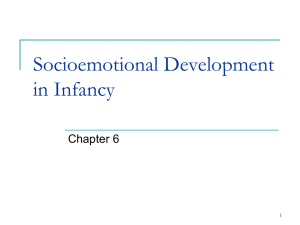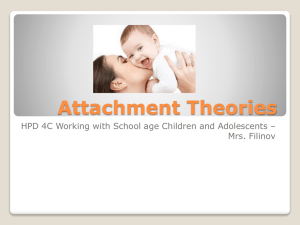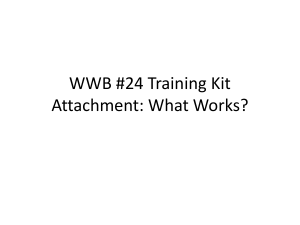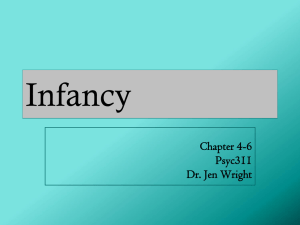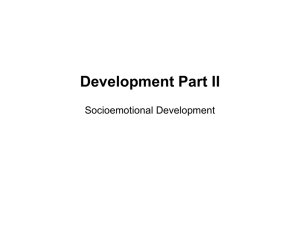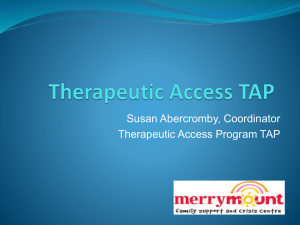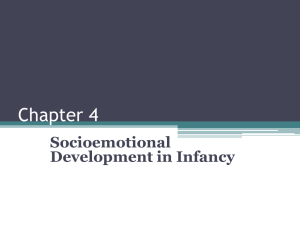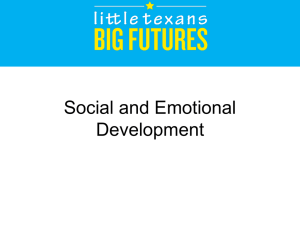- Geoff Fitzgerald
advertisement
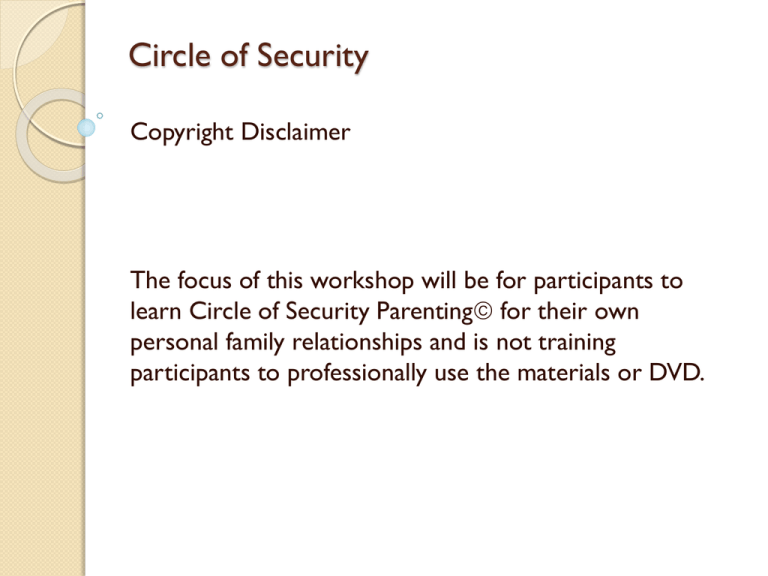
Circle of Security Copyright Disclaimer The focus of this workshop will be for participants to learn Circle of Security Parenting for their own personal family relationships and is not training participants to professionally use the materials or DVD. If only it were this easy... Imagine this... Underpinning Principles of COS. * COS is a relationship based parenting program targeted at supporting secure attachment between parents and infants * It adopts the standpoint that we are all hardwired to want to feel secure (The Great Pull), and attempt to do so in relationship with another (“And”) * The focus is on developing the parent/child relationship rather than developing specific behaviour management strategies. It is based on the premise that by being able to respond to or cue our children effectively many behavioural issues are more readily managed (providing a Road Map) * COS offers a coherent world view and vocabulary for understanding what’s going on: in the child and in the self The Great Pull and “&”... The Circle of Security approach is always about helping caregivers more fully recognize and honour this “Great Pull”, the “And” within themselves and their children. It does this by providing a simple road map of how this need for AND is hardwired into each of us and is always hidden in plain sight. It helps us to move from only seeing what we expect to see, to knowing what to look for and seeing what was hidden in plain sight. COS provides a “When/Then” decision making framework. A shift from “What does this child want from me???!!!” to “Oh, I see what he/she needs (and it’s very easy to understand).” Background - Psychobiological regulation There is now widespread agreement that the brain is a self organizing system, but there is perhaps less of an appreciation of the fact that the self organization of the developing brain occurs in the context of a relationship with another self, another brain. The other self, the primary caregiver, acts as an external psychobiological regulator of the “experience-dependent” growth of the infant’s nervous system, whose components are rapidly organizing, disorganizing, and reorganizing in the brain growth spurt of the first two years of life. Schore, A.N. (1996) The experience dependent maturation of a regulatory system in the orbital prefrontal cortex and the origin of developmental psychopathology. Development and Psychopathology Volume 8, #1 Background - Affect synchrony and Affect Regulation “Self regulation develops in the context of mutual regulatory parent-infant systems and the co-ordination of affective expression during face to face interactions. [These] facilitate the transition from mutual regulation to self regulation” – Alan Schore, Ph.D. Background- Emotional dysregulation When infants are emotionally dysregulated they are at the mercy of these states. * Until these states are brought under control, infants must devote all of their regulatory resources to reorganize them; * While they are doing that, they can do nothing else; * These infants forfeit potential opportunities for socioemotional learning. Tronick, E. & Weinberg, K. Depressed mothers and infants: failure to form dyadic states of consciousness. In: Murray, L.,Cooper, PJ, Eds. Post partum depression in child development. New York: Guilford Press, 1997: 54-81. Attachment Theory The three systems we need to know to understand attachment: care seeking care giving exploration Attachment Theory Attachment The child’s relationship with the parent, rather than the parents’ with the child. Meaning that the child turns to the parent for support and not the other way around. Parents have an affectional bond to their child but are not attached to them. The attachment relationship is: Persistent or ongoing, not temporary Directed toward a specific person Emotionally significant Directed toward maintaining contact with the other Characterised by distress during periods of involuntary separation Characterised by seeking security and comfort (unique to attachment as opposed to the other 5 which are shared by affectionate attachment) Attachment Theory Organised attachment: child manifests a predictable series of responses to attachment figures when in distress: Avoidant: independence at the expense of relationship. Ambivalent: relationship at the expense of independence. Disorganised: neither able to successfully rely on themselves or their parents in any consistent way. Tend to try to rigidly control events in their lives to create a sense of safety by avoiding stressful events since they lack self reliance and relationship skills that might help manage stressful situations. Key Components of COS – TOP Support My Exploration (Uniqueness/Autonomy/Top) Watch over Delight in me – my being Help me Enjoy with me – my mastery Key Components of COS – BOTTOM Welcome My Coming to You And Fill My Cup (Vulnerability/Comfort/Bottom) Protect me Comfort me Organise my feelings Delight in me Key Components of COS – HANDS ALWAYS: be bigger, stronger, kinder and wise WHENEVER POSSIBLE: follow my child’s need WHENEVER NECESSARY: take charge Bigger, stronger, without kind can be experienced as “mean” Kind without bigger, stronger can be experienced as “weak” The absence of these is experienced as “gone” Key Components of COS – BEING WITH * Is a state of mind where we allow ourselves to be vulnerable enough to follow and hold our child’s feelings along with whatever feelings also get stirred up in us, and help them to organize what they are feeling. It is having us with them in their emotions. * Many of us often find it easier to be with our children when they are feeling happy. When they are struggling emotionally we often find it more difficult and want to get them back to feeling happy by distracting or talking them out of their distress. This often intensifies and prolongs our child’s distress. * How we react to our children’s emotions (cue vs miscue) teaches them whether feelings can be shared or need to be hidden, and whether they can face their feelings or need to escape from them. BEING WITH – Points to Ponder What emotions were your caregivers able to fully help you with? 2. What emotions were they partially able to help you with? 3. What emotions were they not able to help you with? 4. What might the implications be for us as adults 1. When parenting our own children? 2. In intimate relationships? 3. As clinicians? 1. Key Components of COS – SHARK MUSIC Tells us to be afraid of a feeling or need that’s actually safe Changes our response to a situation Creates “limited circles” often featuring miscues Limited Circles – Points to Ponder How might caregiver shark music on top lead to a child fearing separation? How might caregiver shark music on bottom lead to child fearing closeness? What strategies might children adopt in response to limited circles” How might these manifest as adolescents? As adults within intimate relationships? Implications as clinicians?

